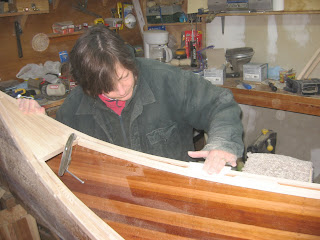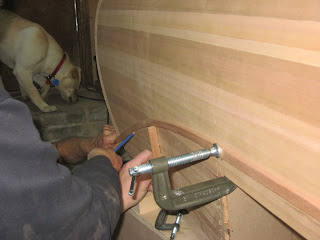
Monday, July 6, 2009
Varnishing
Randy designed and built the seats. The cane and the birdseye maple yolk were purchased, however.
 This is what in the inside of the canoe looked like when the varnishing was completed. Three coats of varnish were put on the inside and outside. Between coats, the surface was wet-sanded using 400 grit sandpaper so that the finish would be perfectly smooth. We used the highest quality high glass marine varnish.
This is what in the inside of the canoe looked like when the varnishing was completed. Three coats of varnish were put on the inside and outside. Between coats, the surface was wet-sanded using 400 grit sandpaper so that the finish would be perfectly smooth. We used the highest quality high glass marine varnish.
 This is what in the inside of the canoe looked like when the varnishing was completed. Three coats of varnish were put on the inside and outside. Between coats, the surface was wet-sanded using 400 grit sandpaper so that the finish would be perfectly smooth. We used the highest quality high glass marine varnish.
This is what in the inside of the canoe looked like when the varnishing was completed. Three coats of varnish were put on the inside and outside. Between coats, the surface was wet-sanded using 400 grit sandpaper so that the finish would be perfectly smooth. We used the highest quality high glass marine varnish.Sanding and Scraping
Re-Attaching the Gunnels
Finishing the Inside
Sunday, April 19, 2009
Inner and Outer Wales On
The outer gunnel was attached using 1 1/2" screws that were countersunk. We will make plugs to fill the holes later. The plugged screw holes add to the overall athestic of the canoe. The final sanding on the top side of the gunnel was done by hand, as is all the finishing sanding.
 After using cabinet scrapers to remove any runs in the epoxy in the interior of the canoe, it was sanded smooth. At least one more coat of epoxy will be applied to create a perfectly smooth surface.
After using cabinet scrapers to remove any runs in the epoxy in the interior of the canoe, it was sanded smooth. At least one more coat of epoxy will be applied to create a perfectly smooth surface.
The Inner Gunnel
Randy cut 3 inch pieces of ash to be used as spacers between the inner gunnel and the canoe body.
 The spacers were attached to the ash inner gunnel using glue and 5/8" screws. The clamps held the spacers tight to the gunnel while the glue dried.
The spacers were attached to the ash inner gunnel using glue and 5/8" screws. The clamps held the spacers tight to the gunnel while the glue dried.
Here is a completed inner gunnel. We were unable to locate a 16' piece of white ash with which to make the gunnels. Randy spliced 2 12' pieces together using a long taper cup to make each of the inner and out wales.

The inner wale was fitted to the canoe and attached using 3/4" screws. The clamps were used to bend the ash to the shape of the body of the canoe.

Final Shear Line
To determine the final shear line, we clamped a cedar strip along the line that had been previously marked. The cedar was bent upward to follow the arch of the canoe. The line was etched into the epoxy with a utility knife.

After the line was etched, excess wood was sanded off using a belt sander. I always get the fun jobs.

Wednesday, April 15, 2009
Fiberglassing the Inside
It was harder to lay the fiberglass inside the canoe. We cut it six inches from each end as there is not way to get the 'glass right into the bow and stern.
 The first coat was applied in the same manner as on the outside.
The first coat was applied in the same manner as on the outside. It was tricky painting the epoxy into the narrow bow and stern.
It was tricky painting the epoxy into the narrow bow and stern.
For the second and third coats, we made sure the epoxy was warmed on the heater. This makes the epoxy much more liquid so that we could apply a thin coat with the roller. Before the epoxy began to set at all, the coat was dry brushed to remove any roller marks and make for a perfectly smooth finish.
Sanding the Inside
Due to the curverature of the inside of the canoe, all the sanding had to be done by hand.
More Coats
You have to apply sufficient epoxy on the first coat to saturate the cloth through to the wood so that the cloth adheres to the wood. Once the epoxy sets up somewhat, the excess is squeegeed off and discarded.
Laying the Fiberglass on the Outside
Sunday, February 22, 2009
Creating the Shear Line
Next the shear line had to be determined and cut. A cedar strip was clamped to the bottommost cedar strip.
 Randy transferred the shear line marks from the molds to the outside of the cedar planking and then bent the strip to follow the marks which go from the level of the last cedar strip to the level of the top of the stem. Using a cedar strip to form the line guaranteed a perfect curve.
Randy transferred the shear line marks from the molds to the outside of the cedar planking and then bent the strip to follow the marks which go from the level of the last cedar strip to the level of the top of the stem. Using a cedar strip to form the line guaranteed a perfect curve.
 Randy transferred the shear line marks from the molds to the outside of the cedar planking and then bent the strip to follow the marks which go from the level of the last cedar strip to the level of the top of the stem. Using a cedar strip to form the line guaranteed a perfect curve.
Randy transferred the shear line marks from the molds to the outside of the cedar planking and then bent the strip to follow the marks which go from the level of the last cedar strip to the level of the top of the stem. Using a cedar strip to form the line guaranteed a perfect curve.
Subscribe to:
Posts (Atom)



































